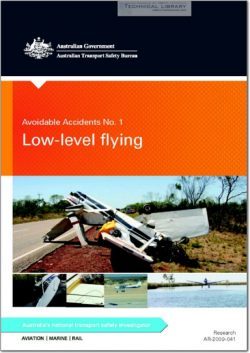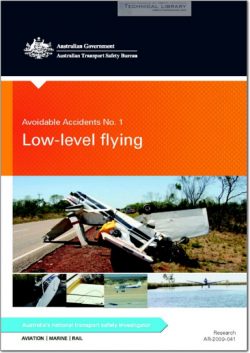ATSB-AR-2009-041

- Version
- 161 Downloads
- 8.06 MB File Size
- 1 File Count
- August 9, 2016 Create Date
- August 9, 2016 Last Updated
Avoidable Accidents No.1 - Low Level Flying

This publication is the first in a pilot education series by the Australian Transport
Safety Bureau (ATSB) on avoidable accidents. In this report, we will focus on
accidents involving unnecessary and unauthorised low flying; that is, flying lower
than 1,000 ft (for a populous area) or 500 ft (for any other area) above ground level
without approval from the Civil Aviation Safety Authority (CASA).
Between 1999 and 2008, there were 147 fatal accidents reported to the ATSB
involving aerial work, flying training, private, business, sport and recreational
flying in Australia. Of those fatal accidents, at least six were associated with
unauthorised and unnecessary low flying. Those six accidents, along with a seventh
non-fatal accident, presented here as case studies, were chosen by aviation
safety investigators at the ATSB to highlight the inherent dangers of unauthorised
low flying and to offer some lessons learnt from each case. It is hoped that these
lessons learnt will help pilots make more accurate risk assessments and better
decisions before electing to fly at low levels.
At low altitudes, there are many obstacles to avoid and there is a lower margin for
error. Recognising the risks and hazards of low—level flying, CASA requires pilots to
receive special training and endorsements before they can legally conduct low-level
flying. In the accidents described in this booklet, most of the pilots had neither of
these, and none had a legitimate reason to be flying below 500 ft. Some legitimate
reasons for flying at low level include aerial stock mustering, crop spraying, and
fire fighting operations. For most private pilots, there is generally no reason to fly at
low levels, except during takeoff and landing, conducting a forced or precautionary
landing, or to avoid adverse weather conditions.
What is sad and unfortunate about the accidents described in the following case
studies is that they were all avoidable.
| File | Action |
|---|---|
| ATSB-AR-2009-041 Avoidable Accidents No.1 - Low Level Flying.pdf | Download |

Comment On This Post